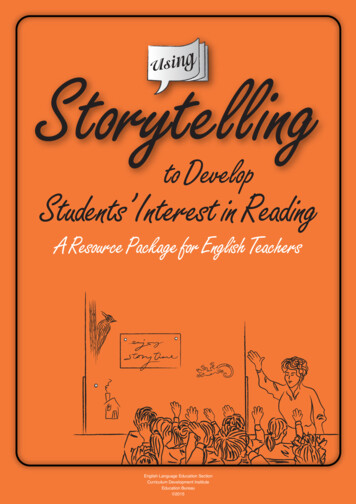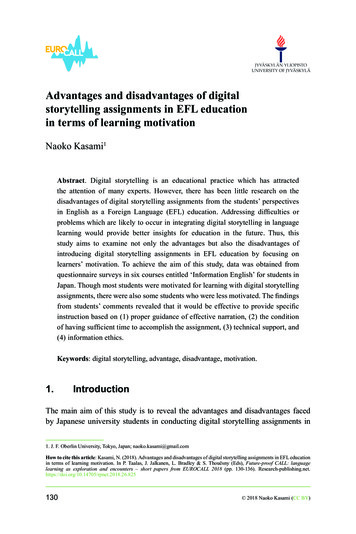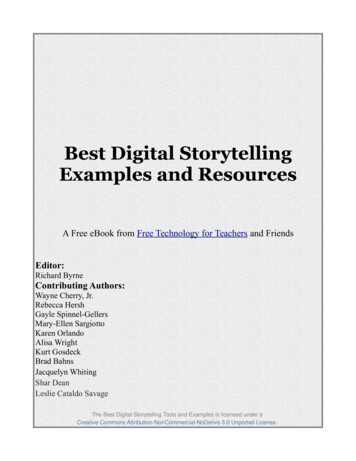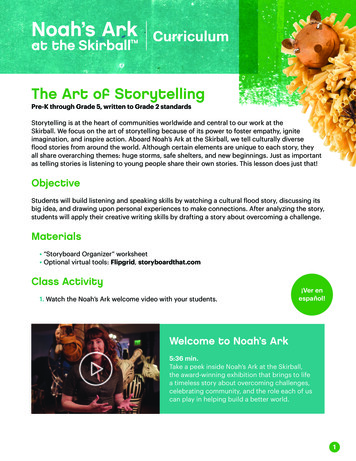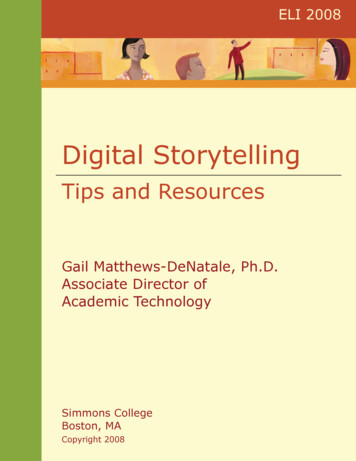
Transcription
Universal Journal of Educational Research 7(1): 55-65, 2019DOI: al Storytelling in the Language Arts ClassroomPınar Girmen1,*, Ümit Özkanal1, Gökhan Dayan21Faculty of Education, Eskisehir Osmangazi University, Turkey2Seker Elementary School, TurkeyCopyright 2019 by authors, all rights reserved. Authors agree that this article remains permanently open access underthe terms of the Creative Commons Attribution License 4.0 International LicenseAbstract The aim of this study is to define the role ofdigital storytelling in improving writing skills. The studywas designed as an action research. The study sampleconsisted of 22 fourth grade students in a public elementaryschool in Eskişehir, Turkey. Data were collected in2017-2018 fall term through full participant observation,researcher’s diaries, students’ diaries, student digitalprocessing products and video recordings. The learningmaterials were developed by the researchers based on theenriching texts and in-class action plans were designedbased on the steps of digital storytelling. Data collectedwith researcher’s diaries, observations, video recordingsand documents were analyzed using content analysis. Theresults showed that digital story writing studies could bevery effective in developing the writing skills ofelementary school fourth grade students. Also, the digitalstory writing activities improved the students’ computerliteracy as well as their attitudes and motivation towardswriting. Particularly, integration of technology in writingactivities let the students see the course as a more modern,innovative and attractive course.not starting a sentence with a capital letter and misspelling,words and syllables, and the problems in terms of contentare lack of logical connections and content integrity amongthe sentences in a paragraph [27, 2, 12]. It may be statedthat writing skill improves much slower than the otherskills or does not improve enough because of high numberof students in classes or some problems caused byteachers since it is a complex process, the feedback andcorrection processes during practice are not functionalenough [21]. Numerous models and theories have beenput forward regarding how writing skill may be gainedand improved [19, 39, 31]. Although many studies haveput forward that writing skill has been improvedsignificantly based on the models and theories, howwriting teaching and technology in the light of developingtechnology can be integrated is still a problem, whichcontinues to be relevant. Digital storytelling is one of thesteps, which may be a solution to the problems facedduring the development of writing skill. Digital storytelling,which is a functional approach in integrating writing skillwith technology, is also used in enriching learningWriting Skills, Digital Storytelling, environments. There are many different definitions ofKeywordsdigital storytelling, but in general, they all revolve aroundLanguage Arts, Elementary Educationthe idea of combining the art of telling stories with a varietyof digital multimedia.Digital stories bring together some mixture of digitalgraphics, text, recorded audio narration, video and music to1. Introductionpresent information on a specific topic [28]. DigitalWriting, one of the four language teaching skills, is a storytelling approach has an important potential, whichrelatively late developing skill with cognitive and physical may be an educational model for the current era. Digitalprocesses [18]. Writing serves both as a way, which is a storytelling can also contribute in educating individualsway to share our life experiences and to acquire regular who can analyze and interpret audio-visual outputs. Hence,thinking habit together with communication. Therefore, the it is an important, creative and functional approach for thedevelopment of writing skill also involves the development new generation who will lead the future education [7] andof thinking ability [32]. Developing writing skills help can help improve writing skills of students. In terms ofstudents express their feelings, opinions, imaginations, developing writing skills, it is important that writing skillsnotions and impressions on anything by using the language course, which is a substantial skill in teaching languages,based on grammatical rules [24].should be integrated with technology and the learningThe studies carried out in Turkey depict that most outcomes should be analyzed. The aim of this study is tostudents have a weakness of writing skill. In fact, in terms define the role of digital storytelling in improving writingof style, the most frequent problems are lack of punctuation, skills.
56Digital Storytelling in the Language Arts Classroom2. Methodology2.1. Research DesignThe study was designed as an action research, one of thequalitative research methods, since it aims to define,describe the circumstances experienced during theapplication of digital storytelling in detail in the writingprocess of elementary school fourth grade students andoffers a solution to the possible problems and deficiencies,which may be faced. Action research is described as asystematic research by which information on how schoolruns, how teaching is carried out and how students maylearn better is obtained and it is carried out by teachers,principals, schools consultants or by other shareholders ofteaching and learning environments [25].2.2. ParticipantsPlanning, a suitable teaching process was designed tohave students write a digital story since the aim of the studywas to improve students’ writing skill with the help ofdigital storytellingAct. Action theory was applied in order to check how theteaching and studies worked when the data were gatheredsystematically.Observe. In this process, the relation between what wasobtained and actions realized and the findings wasdetermined.Reflect. In the last phase of action research, analysis,planning and reporting actions were carried out. The dategathered were analyzed and the results obtained were usedin the revision of action plans.2.4. Data Collection and AnalysisData were collected in 2017-2018 fall term in a ten-weekprocess by the researcher through full participantThe study sample consisted of 22 students, 10 male andobservation,researcher’s diaries, students’ diaries, student12 female, in a public elementary school in Eskişehir,digitalprocessingproducts and video recordings. TheTurkey. The participants were selected using the criterionlearningmaterialsweredeveloped by the researchers basedsampling, a purposive sampling method. Criterionontheenrichingtextsand in-class action plans weresampling involves examining all situations containing adesignedbasedonthestepsof digital storytelling. Thevariety of pre-determined criteria [37]. The inclusionactionplanspreparedwerepresented to the validitycriteria were that students attended a school that did notcommitteeandfieldexpertsandnecessary correctionshave a computer lab and were located in a lowweredonebasedonthefeedbacks.socio-cultural area, and that students did not have any ideaData collected with researcher’s diaries, observations,on digital storytelling processes. The study samplevideorecordings and documents were analyzed usingincluded fourth grade students mainly because it wascontentanalysis. Just before the implementation of theassumed that the students would have computer technologycontentanalysis,the notes taken by the researchers duringskills and writing skills at a certain level. The school intheobservationandstudents’ diaries were examined inwhich the study was carried out was located in a lowdetailandtranscribedon computer using a word processor.socio-economic area.The qualitative data in the video recordings were textedinto the computer and they were formed as textual data2.3. Action Research Modelproper for the analysis. Digital outputs by the students andThe action research cycle was drawn on in this study. screen shots of all acts were gathered by the researcher andThis model has its origins in the work of Kurt Lewin (1946). turned into analysis data. The data texts in the computer onThe model involves deciding on a particular focus for observation and diaries were divided into meaningful parts,research, planning to implement an activity, series of named by the researchers and a code list was formed.activities , or other interventions, implementing theseDuring the coding process, the conceptual frame of theactivities, observing the outcomes, reflecting on what has study was taken into consideration. After bringing all thehappened and then planning further activities if necessary codes together, the common directions among the codes[10]. Figure 1 depicts the action research cycle used in the were formed. The data obtained were categorized and thestudy.themes forming the main lines of the researchers’ findingswere reached.The available coding list and themes were finalizedbased on the opinions of the experts.The quotations were given directly with initials likevideo recording (V. R.), researcher’s diary (R. D.) andstudents’ diary (S. D.). The themes, sub-themes and codesof the study are depicted in Table 1.Figure 1. Action Research Model
Universal Journal of Educational Research 7(1): 55-65, 201957Table 1. Themes, Sub Themes and CodesTHEMESReflections of Writing ProcessSUB-THEMESWriting SkillUse of ComputerTechnologiesLearning massReflections on Learning Environment2.5. Validity and ReliabilityReflections on theCourseCODESSpelling and PunctuationDigital Story ElementsCreating TextPreparatory StudiesKeyboard KnowledgeSearching in the NetCooperationPeer LearningAttitudeMotivationSelf Confidencethe practice classroom.The conclusiveness (i.e., accuracy, validity, reliability)in qualitative studies means the observation and transfer ofthe data as they are or as neutral as possible [22]. On theother hand, the repeatability (i.e., reliability, transferability,approvability) states that similar situations may occur [37].The necessary permissions from the institution, students,teachers and parents were obtained in the study. Theopinions of the experts and validity committee on actionplans and the appropriateness of the enriching texts wereapplied and corrections were made accordingly.At the same time, the variety of researcher was tried toget with the study of the data by the researchers separately.The data were presented to the validity committee that metregularly and their opinions on the study were obtained.Doing so, the reliability of the study was tried to get. Onthe transferability of the study, detailed descriptions anddirect citations were included in the presentation of thefindings. Therefore, it can be stated that the results of thestudy can be applied in classes having the same conditionsand those having better conditions.2.6. Application of the ResearchIn this part, the process of the research from the startuntil the end is defined. The codes of practice showing thestages of the research, the action plan, are shown in Figure2 in detail.Deciding on a Web-based Video Formation Software.The web-based video formation software “GoAnimate”including lots of scenes and cartoon characters was chosenfor the research.Deciding on the Activities for Digital Story Making. Thestrategy to decide on which activities to use, was to followthe way from simple to complex ones. For this purpose,activities for making dialogues, making descriptions,making advertisements, informative texts and stories wereincluded.Supporting the Technological Background of the School.The inadequate number of computers was increased forbeing able to perform the digital narrative activitiessmoothly. A digital camera and a tripod were placed intoFigure 2. The Codes of Practice for the Research ProcessIntroducing the Computer Software to Students. Beforethe start of the process, the researcher had come togetherwith the group of 22 students in classroom environmentand informed them about digital narration. In addition tothis, a presentation was prepared by the researcher topresent the features and the use of the web site for anadequate application of it.By this, students were equipped with the necessaryinformation for the use of the web site.Deciding on the Warm-up Activities. The identificationof the items as supportive content presented by theresearchers was actualized before digital stories were made
58Digital Storytelling in the Language Arts Classroomup. Within this framework, the visuals, descriptive texts,coloring practices, sample dialogues, informative texts andcartoons to be used during teaching-learning process weredetermined.Digital Narration Process. Digital narration stepsconsisted of forming the scenes, adding the written work,giving effects, and arrangement and correction. Througheach phase, the researcher watched, guided and observedthe students and helped the ones in need during theproduction of digital output.Sharing. The digital stories formed by the students wereshared by the target group at this phase. Before startingforming their digital stories, the students were informedabout who they were going to form their stories for. Thetarget group had been defined before forming the digitalstories.2.7. Working Calendar of the StudyThe activities carried out are depicted based on week andclass hour in Table 2.3. FindingsIn the presentation of the findings and comments, thethemes found out by the content analysis were consideredand the citations which best explain the theme wereincluded. Intended for the purpose of the research, the datagathered via video recordings, student and researcher,student products and voice recordings were analyzed and itwas aimed to form a profound frame for the use of digitalnarration study in teaching writing.Table 2. Working Calendar of the StudyBriefing/Created TextsTechnical Briefing on DigitalStory tellingWeekTime1160 m2160 mIntroduction of Digital Storytelling Phases160 mCreating Dialogue80 mOutput Presentation160 mCreating Person/Object Imagery80 mOutput Presentation5120 mCreatingAdvertisement640 mOutput Presentation7160 mCreating Information Texts8120 mOutput Presentation9200 mCreating Story10160 mOutput Presentation34Practice Notes/Enriching ActivitiesIntroduction of the website.Creating scenes, adding script,effects and musicPuppet videos were watched asenriching texts and texts with dialogueswere presentedOutputs formed by pairs werepresented in classPausing the tales listened in classa discussion setting was createdIndividual Outputs were presentedin classAdvertisement videos were watched.Advertisements on school introductionwere shared with other 4th class studentsA brochure about the city’s cultural andtourist attraction places was shared anda city introduction video was watched.Outputs prepared was presented tofirst grade students who weredetermined as target groupAn animated video was watchedas enriching textOutputs were presented to the students’families as target group
Universal Journal of Educational Research 7(1): 55-65, 201959The Reflections on the Writing ProcessWhen the digital stories of the students were studied,although the first drafts were full of mistakes, it wasobserved that this problem decreased gradually. Eventhough almost no punctuation was used in the first drafts,some progress relating to the matter was made onwards thesecond drafts. When observed in terms of punctuation, itwas analyzed that all students used correct punctuation intheir final work. This could be related with the immediatefeedback of the researcher, the group work of the studentsand their high motivation on digital story formation. Whenthe first drafts were studied in terms of spelling rules, it isobserved that there were missing or wrong letters in words,some incorrectly adjoined conjunction and question wordmistakes, and also no space was left between words. Someexamples of the first draft mistakes are as follows:(Thank you for saying it)Note. “https://goanimate.com/” [20]Correct Sentence: “Söylediğin için teşekkür ederim.”Figure 5. Leaving no space between wordsIt was found that the spelling mistakes decreased duringthe process of the student outputs. The most significantreason for this improvement was most probably thesubsidiary role of the computer. This aspect of thecomputer software provided immediate self-correctionopportunity to the student. The feedback from theresearcher was also one of the other reasons for thedecrease. It was observed that there were almost nomistakes as the process progressed. Some examples of theimprovement in this respect are as follows:(Shall we buy this for you?)Note. “https://goanimate.com/” [20]Correct Sentence: “Bunu sana alalım mı?”Figure 3. Missing letter(It is very enjoyable to do this movement)Note. “https://goanimate.com/” [20]Correct Sentence: “Bu hareketi yapmak da çok eğlenceli.”Figure 6. Mistakes in the first digital outputTable 3. Types of mistakes in the first digital outputNot capitalizing the first letter of the sentence(The color of the balloon is black)Writing the words without leaving space between wordsNote. “https://goanimate.com/” [20]Adjacent use of conjunctionsCorrect Sentence: “Balonun rengi siyah.”Not punctuatingFigure 4. Wrong letterMissing letterWrong letter use
60Digital Storytelling in the Language Arts Classroom(We should give up our seats to the elderly and pregnant)Note. “https://goanimate.com/” [20]Correct Sentence: “Yaşlılara da, hamilelere de yer vermeliyiz.”Figure 7. Mistakes in the second digital outputTable 4. Types of mistakes in the second digital outputMissing letterAdjacent use of conjunctionsNot punctuatingNote. “https://goanimate.com/” [20](We drove his car but it broke down on the way)Correct Sentence: “Onun arabasını kullanmıştık. Ama o dayolda bozuldu.”Figure 9. Mistakes in the fourth digital outputTable 6. Types of mistakes in the fourth digital outputAdjacent use of conjunctionsNote. “https://goanimate.com/” [20](Ahmet was without water for a long time. He was about to pass out.However, this did not discourage him)(I am late for the class too)Note. “https://goanimate.com/” [20]Correct Sentence: “Ben de derse geç kaldım.”Figure 8. Mistakes in the third digital outputTable 5. Types of mistakes in the third digital outputAdjacent use of conjunctionsNot punctuatingFigure 10. Error-free sentence in the fifth digital outputIn this respect some statements from student are asfollows:“At the beginning, my sentences seemed correct to me. Ilater on realized that I had some mistaken parts in mywork.”(S.D.4, 05.10.2017).
Universal Journal of Educational Research 7(1): 55-65, 2019“As long as the activities proceeded, the change in mywriting distinguished itself. I used to make too manymistakes on conjunctions. I sometimes didn’t punctuatefull stops. Then I started to correct myself.”(S.D.6,10.10.2017).“Our teacher used to tell us about our mistakes. S/heused to correct us at once. I took her corrections intoconsideration and improved my writing.”(S.D.7,12.10.2017).“The computer automatically underlined the misspelledwords. I usually noticed my mistake on the screen. Ourteacher also pointed out my mistakes immediately.”(S.D.1, 13.10.2017).When the outputs investigated in terms of using of thedigital story elements, it was seen that most students couldnot add any audial or visual effects to their digital stories.The outputs in the beginning came out without music andas short scenes. It can be stated that with the third digitaloutput students started to add music together with audialand visual effects. Similarly, while preparing the thirddigital output, the students showed the ability of choosingcorrect character for the theme and proper facialexpressions.The students acquired the ability of adding movement tothe characters in the third digital output. The diary of theresearcher is as follows:“The number of scenes has increased when comparedwith the first output. This also applies with the videoduration of the scenes. Each scene in digital output takesten seconds. They have learnt how to increase durationof the scenes and arranging them in accordance with thelength of the speeches. They can use the durationarrangement part effectively at the sub-section of thesoftware. “ (R.D. 11, 16.10.2017).“The facial expressions of the characters are quite clearbased on the story. The facial expressions of thecharacters change accordingly. They, now, can addmovement easily that they have not been able to do atfirst. The more they have used them, the happier theyhave become. They are especially happy when flying thecharacter” (R.D. 14, 23.10.2017).61(I have woken up very happy)Note. “https://goanimate.com/” [20]Figure 12. The expression of happiness(Because he got my pen without my permission)Note. “https://goanimate.com/” [20]Figure 13. The expression of tearful(Our character was very worried)Note. “https://goanimate.com/” [20]Figure 14. The expression of sorry(What should I do now in this situation?)Note. “https://goanimate.com/” [20]Figure 11. The expression of confusedWhen the students’ digital outputs studied in terms offorming stories, major differences between the first and lastoutputs were observed. While their outputs were of shortsentences, when they proceeded it was seen that theystarted to use conjunctions. Not clear acts, low number ofcharacter and short sentences were replaced with detailedexpressions.Similarly, the students put forward their messages intheir last two outputs. The main reason for this change
62Digital Storytelling in the Language Arts Classroommight be the pre-preparing texts presented to the students.That in their outputs, they had some inspirations from thetexts they listened to or watched might be the reason of thisdevelopment.When the students’ outputs were studied in terms ofpre-preparing texts, it may be stated that the students wereaffected a lot what they listened to and watched. It was seensome concrete tracts of pre-preparing texts in the outputs.The discussions done and the points the researcher putforward after watching and listening activities were alsoreflected in the outputs. This can be seen in the videorecording as follows:Researcher: I want you to take these into consideration.Student 1: Teacher, got it! Just like the cartoon we havewatched. Since it is rainy, they should take what youhave shown (V.R. 11, 17.10.2017).Researcher: Do you like the video?Students: Yes teacher.Researcher: Well, has this video created anything inyour mind? Where do you think it can be used?Student 8: It is suitable for my scene for example. I canuse the animals here when the duck has run away fromthe hunter (V.R. 13, 19.10.2017).“The visuals they want to implement in their studies arenot always available in the software they use. I direct thestudents who want to use different visuals to do search inthe “Google”. Those not having enough ability to usethe technology are in real difficulty in finding and savingthe proper visual. I am teaching them how to get theproper visual by using some key words and save to thecomputer so that they can use it later” (R.D.21,03.11.2017).It was seen that when digital story making processproceeded, the students were able to implement propervisuals they got from the Internet. In the last digital story,the captions on visuals that they received in the net arebelow.As seen above, it can be stated that the pre-preparingtexts affected and revived the students.When the digital story process of the students studied, it(Which color is better for you?)was found out that they lacked of knowledge in terms of(The dresses are great.)computer literacy. They were observed to be lackingNote. “https://goanimate.com/” [20]knowledge of keyboard and searching ability on theFigure 15. Dressed downloaded from Google VisualsInternet. It was witnessed that in terms of keyboardknowledge, they had difficulty in using caps lock,backspace, space bar and enter keys. The reason of theproblem might be that they used more tablets and smartphones than computers in their daily lives. During the study,it was observed that they developed themselves incomputer literacy. The reflections of students are asfollows:“I have learnt to use caps lock and put apostrophe in thekey board. Then I have learnt where to find questionmark, coma and full stop. I have also learnt the places ofthe letters in the keyboard. I have experienced the Num(Do not cry anymore, I will buy what you want)Lock key twice.I have learnt that when I press the key, number get active” Note. “https://goanimate.com/” [20](S.D. 12, 17.10.2017).Figure 16. Toys downloaded from Google Visuals“I have learnt to write in capitals and lower case letters.I have just learnt caps Lock. When pressed Ctrl, we can Reflections on Learning Environmentget capital letter. When pressed the key enter, thesentence comes under. When pressed the key having aThe students put forward their digital stories in pairs. Itline over, what you write is deleted. I have just learnt was witnessed that the conflict between them decreased inthem all” (S.D. 10, 25.10.2017).time. It was observed that they learnt a lot on the use ofcomputer and/ or software and shared a lot of informationWhen the students’ ability of searching on the Internetas to the process. It was also seen that the students alwaysstudied, it was observed that at the beginning the studentsworked in cooperation and supported each other inhad difficulty to get visuals and do search in the net fordetermining the characters, places, plots, time and anytheir digital stories. This is reflected in the diary of theelements as to what they did. The video recordings are asresearchers as follows:follows:
Universal Journal of Educational Research 7(1): 55-65, 2019Researcher: Have you downloaded your digital story?Student 3: Yes, teacher. We have finished our work. Hehas used the keyboard and I have moved the mouse. Nowwe are checking it all before downloading.Student 7: We may make some changes on this scene(pointing it out with hand). What do you think?Researcher: It seems nice. I like the flag especially. Ifyou really like, you may change it.Student 7: Teacher, we have chosen that flag togetheramong the other flags in Google visuals.Student 3: Yes teacher, we have chosen the best one.Then we added an atomic bomb effect to the flag and thescript was written in capital letters.Student 7: Teacher, I have taught him how to write incapital letters. The other group has liked that effect toobut they have not been able to find where to get it. Wehave shown them how to.Student 3: I have also taught you how to save it,remember the scene with nutrition?Researcher: Very good, you share your knowledge. Ifyou are not doing any changes, download your digitalstory now. (V.R.22, 06.11.2017).It was found out that the students’ motivation andattitude towards the course had an increasing trend in thestudy of digital story making. It was observed that at firstthe students’ anxiety level when preparing the digitalstories was high but they had curiosity and a will to write.The will to write and their excitement of the students can bedepicted as follows:Researcher: The lesson is about to be over. I want tolearn what you think about what we have been doing sofar.Student 16: Teacher, I have not noticed how fast theclass has gone on, as if we have just started.Researcher: If you raise your hands, I can see whateverybody thinks. Yes, you.Student 20: During my first digital story I have felt alittle bit stressed and I have had the feeling of beingunsuccessful. That’s first, then I have overcome mystress.Student 8: Teacher, I have been wondering what kind ofoutcome I might have had. It has been so nice to do theactivities here than the book only.Student 14: At first I have been afraid to make mistakes.I have been so scared to make something wrong ordelete what I have done. I have been astonished in givingeffect to the texts. This is much more fun even if I havehad some difficulties.Student 6: What I wanted to do a lot is to move thecharacter and also add sound. I have been so happy tohear my own voice.Student 2: What I liked a lot is my own voice in the story.Other cartoons are voiced by others but here I do it withmy own voice since this is mine. Very nice to hear yourown voice in the video (V.R.25, 13.11.2017).63During the digital story making process, the anxiety thestudents had in forming a digital story was replaced byself-confidence. This is how reflected in the researcher’sdiary.“I observe that my students work much harder after theyhave learnt how to use the software. The fear of notbeing able to do anything seen at first has now left itsplace to the happiness of doing something good. Thosewho were afraid of doing anything at the computer nowcan say that “no problem, I can do it”. We have muchbetter results in each trial of voiceover (R.D.27,15.11.2017).When the students created and presented their outputs,they saw that they did it well and started to write with ahigh self-confidence. At the same time, that their computerliteracy developed in time and how to use the softwaresupported their self-confidence. The reflection of studentsis as follows:“I did not use to know how to do search on the net but Inow trust myself more than ever on it. Myself-confidence has arisen (S.D.17, 10.11.2017).I have done the search willingly and in enjoyment. In thepast, I used to search on the books or dictionaries butnow I have learnt that I can do search on the net (S.D.11,14.11.2017).I did not know about Google visuals before. First Idownloaded proper visuals from Google visuals for mystory, then I put them as objects in the software. I can doit easily now (S.D.20, 17.11.2017).The digital story writing, which is totally different fromthe usual activities, gave the students the opportunity ofattendance to the course willingly and has eradicatedmonotonous class atmosphere. This caused thedevelopment of a positive attitude towards the course andincreased the motivati
Digital storytelling, which is a functional approach in integrating writing skill with technology, is also used in enriching learning environments. There are many different definitions of digital storytelling, but in general, they all revolve around the idea of combining the art of telling stories with a variety of digital multimedia.


